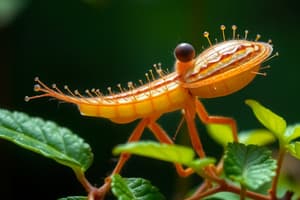Podcast
Questions and Answers
Which characteristic of living organisms involves changes in the structure and function over time?
Which characteristic of living organisms involves changes in the structure and function over time?
- Growth and Development (correct)
- Metabolism
- Adaptation
- Responsiveness
What is the primary function of metabolism in living organisms?
What is the primary function of metabolism in living organisms?
- To respond to stimuli
- To obtain and use energy (correct)
- To increase complexity
- To reproduce
In which domain would you classify organisms that can survive in extreme environments?
In which domain would you classify organisms that can survive in extreme environments?
- Eukarya
- Plantae
- Archaea (correct)
- Bacteria
What type of reproduction involves only one parent organism?
What type of reproduction involves only one parent organism?
What level of biological classification is more specific than the family?
What level of biological classification is more specific than the family?
Which characteristic allows living organisms to make changes to ensure their survival?
Which characteristic allows living organisms to make changes to ensure their survival?
What defines the cellular structure of Eukarya?
What defines the cellular structure of Eukarya?
Which process is NOT typically considered part of metabolism in living organisms?
Which process is NOT typically considered part of metabolism in living organisms?
What is the broadest level of biological classification?
What is the broadest level of biological classification?
Which characteristic of life requires an organism to detect and respond to external changes?
Which characteristic of life requires an organism to detect and respond to external changes?
Which kingdom includes the majority of unicellular organisms that can both produce their own food and consume others?
Which kingdom includes the majority of unicellular organisms that can both produce their own food and consume others?
What characteristic distinguishes the kingdom Fungi from Plantae?
What characteristic distinguishes the kingdom Fungi from Plantae?
In classification systems, what is the significance of phylogenetic trees?
In classification systems, what is the significance of phylogenetic trees?
Which of the following statements about the kingdom Animalia is accurate?
Which of the following statements about the kingdom Animalia is accurate?
Which kingdom is characterized by organisms that form the base of many food webs through photosynthesis?
Which kingdom is characterized by organisms that form the base of many food webs through photosynthesis?
The nutritional strategies unique to fungi primarily involve which of the following processes?
The nutritional strategies unique to fungi primarily involve which of the following processes?
How does the kingdom Protista differ from the kingdom Animalia in terms of cellular characteristics?
How does the kingdom Protista differ from the kingdom Animalia in terms of cellular characteristics?
Which statement describes the overall goal of classification systems in biology?
Which statement describes the overall goal of classification systems in biology?
Among the following choices, which group is known for its significant role in nutrient recycling in ecosystems?
Among the following choices, which group is known for its significant role in nutrient recycling in ecosystems?
What common feature is shared by all four kingdoms within Eukarya?
What common feature is shared by all four kingdoms within Eukarya?
Flashcards
What are cells?
What are cells?
The basic building blocks of all living things, capable of independent functioning. They perform vital processes like metabolism and reproduction.
What is metabolism?
What is metabolism?
The sum of all chemical reactions that occur within a living organism, including those that provide energy and build structures.
What is growth in living organisms?
What is growth in living organisms?
The process of increasing in size and complexity, often involving cell division and specialization.
How do living things demonstrate responsiveness?
How do living things demonstrate responsiveness?
Signup and view all the flashcards
Why is reproduction important for life?
Why is reproduction important for life?
Signup and view all the flashcards
What are adaptations?
What are adaptations?
Signup and view all the flashcards
What is biological classification?
What is biological classification?
Signup and view all the flashcards
What are the three domains of life?
What are the three domains of life?
Signup and view all the flashcards
What are bacteria?
What are bacteria?
Signup and view all the flashcards
What are archaea?
What are archaea?
Signup and view all the flashcards
Protista
Protista
Signup and view all the flashcards
Fungi
Fungi
Signup and view all the flashcards
Plantae
Plantae
Signup and view all the flashcards
Animalia
Animalia
Signup and view all the flashcards
Phylogeny
Phylogeny
Signup and view all the flashcards
Phylogenetic tree
Phylogenetic tree
Signup and view all the flashcards
Classification system
Classification system
Signup and view all the flashcards
Shared ancestry
Shared ancestry
Signup and view all the flashcards
Branching points
Branching points
Signup and view all the flashcards
Branching characteristics
Branching characteristics
Signup and view all the flashcards
Study Notes
Characteristics of Living Organisms
-
Living organisms exhibit a set of shared characteristics, defining their biological organization and functioning.
-
Organization: Living things are composed of cells, the fundamental units of life. This cellular structure forms tissues, organs, and organ systems, highlighting the complexity of biological organization.
-
Metabolism: Living organisms carry out chemical reactions (metabolism) to obtain and use energy for growth, repair, and reproduction. This involves processes like respiration and photosynthesis.
-
Growth and Development: Living organisms increase in size and complexity over time through cell division and differentiation. Development refers to the changes in form and function throughout their lifespan.
-
Responsiveness: Living organisms react to stimuli from their environment, exhibiting behaviours that maintain their well-being. This may include movement, adaptations, or changes in physiology in response to environmental factors.
-
Reproduction: Organisms create new individuals, enabling the continuation of their species. Reproduction can be asexual, involving a single parent, or sexual, requiring two parents.
-
Adaptation: Living organisms have evolved structures, functions, or behaviours that allow them to thrive in their specific environment. These characteristics give them an advantage for survival and reproduction.
Classification of Living Organisms
-
Biological classification systems organize living organisms into groups based on shared characteristics, reflecting evolutionary relationships.
-
Hierarchical Structure: A hierarchical system, starting with broad groups like domains and kingdoms and progressing to increasingly specific categories like species, genus, and family, organizes organisms.
-
Domains: The three domains of life – Bacteria, Archaea, and Eukarya – encompass all living organisms and represent the highest level of classification.
-
Bacteria: Prokaryotic organisms, typically unicellular, with no membrane-bound organelles and a relatively simple cellular structure.
-
Archaea: Prokaryotic organisms that may thrive in extreme environments (like hot springs or salty water), exhibiting unique biochemical adaptations.
-
Eukarya: Organisms with eukaryotic cells, containing membrane-bound organelles and a more complex cellular structure, encompassing protists, fungi, plants, and animals.
-
-
Kingdoms (within Eukarya):
-
Protista: A diverse group of mostly unicellular eukaryotic organisms, both autotrophic and heterotrophic.
-
Fungi: Eukaryotic organisms often involved in decomposition. They are often multicellular and have unique nutritional strategies.
-
Plantae: Eukaryotic, multicellular organisms capable of photosynthesis, generally forming the base of many food webs.
-
Animalia: Eukaryotic, multicellular organisms that are heterotrophic and often mobile.
-
-
Evolutionary Relationships: Classification systems aim to reflect the evolutionary relationships between organisms, grouping species that share a common evolutionary history. Phylogenetic trees depict these relationships, using branching patterns and branching characteristics, and provide insights into the evolutionary pathways of life.
Studying That Suits You
Use AI to generate personalized quizzes and flashcards to suit your learning preferences.






